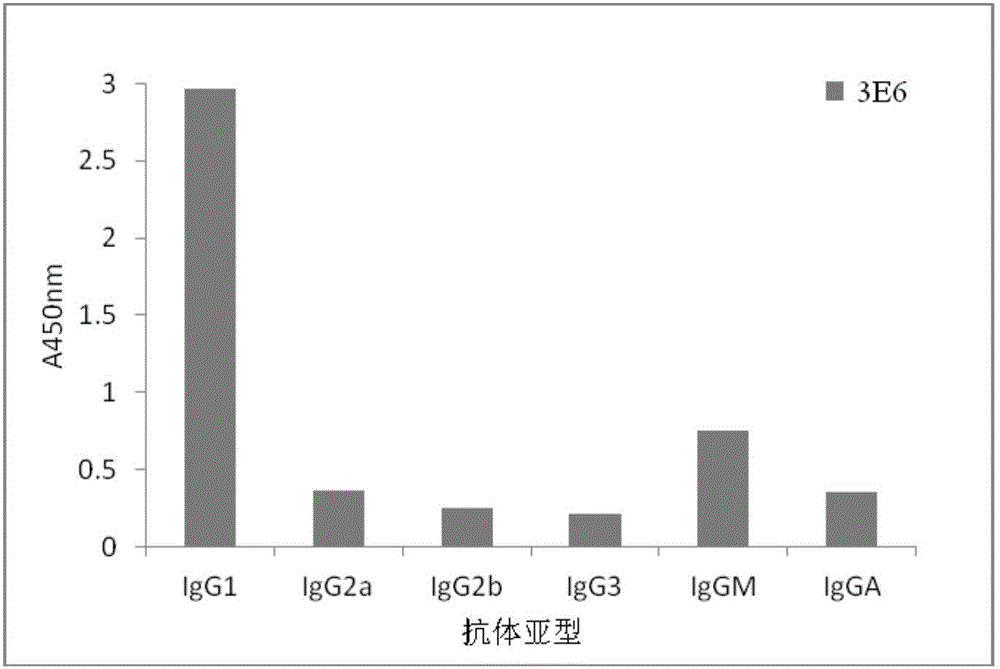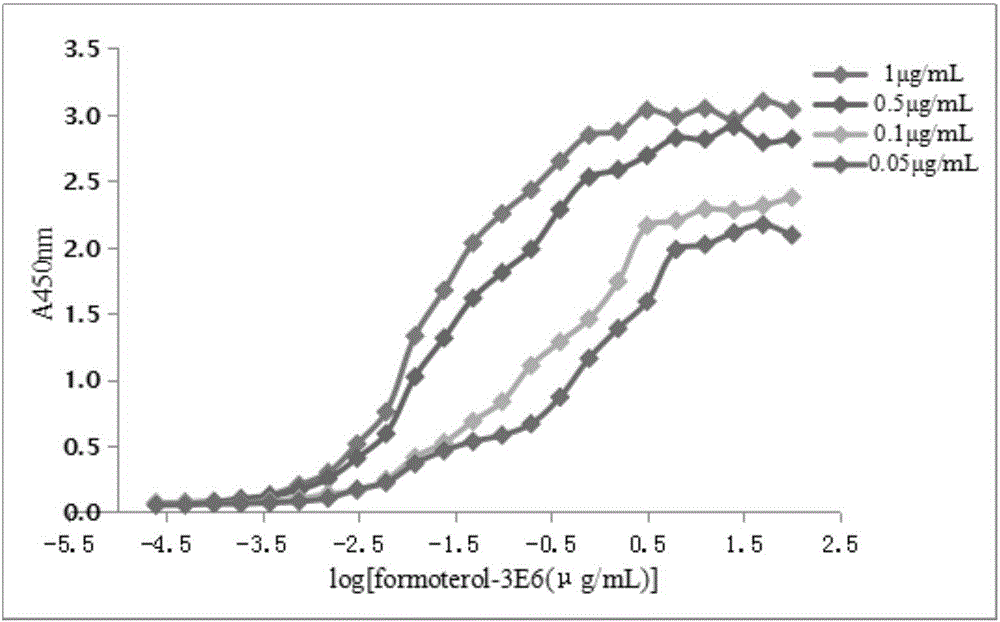Formoterol resistant monoclonal antibody and application thereof
A monoclonal antibody, formoterol technology, applied in the fields of immunology and veterinary drug residue analysis, can solve the problems of high experimental equipment and technical requirements, cumbersome operation, not suitable for rapid detection of large quantities of samples, etc., to achieve strong controllability and repeatable effects
- Summary
- Abstract
- Description
- Claims
- Application Information
AI Technical Summary
Problems solved by technology
Method used
Image
Examples
Embodiment 1
[0041] Embodiment 1 Preparation of formoterol antigen of the present invention
[0042] (1) Preparation of activated p-aminobenzoic acid: take 6 mg of sodium nitrite, dissolve it in 0.35 mL of distilled water, then weigh 10 mg of p-aminobenzoic acid, dissolve it in 1.1 mL of 1mol / L hydrochloric acid, stir in an ice bath, and The above-mentioned sodium nitrite solution was added dropwise to the p-aminobenzoic acid solution, and reacted in the dark for 1 hour to obtain activated p-aminobenzoic acid;
[0043] (2) Preparation of formoterol active intermediate with carboxyl group: Weigh 30 mg of formoterol and dissolve it in 5 mL, 0.05 mol / L ice-cold borax buffer solution (pH=9, containing 0.15 mol / L chlorine sodium chloride), stirred in an ice bath, this solution was added dropwise to the activated p-aminobenzoic acid solution, and reacted in the dark at 4°C for 3 hours to obtain a carboxyl-containing formoterol active intermediate solution;
[0044] (3) Synthesis of immunogen: A...
Embodiment 2
[0046] Example 2 Preparation of formoterol monoclonal antibody of the present invention
[0047] (1) Animal immunization: immunize 6-8 week-old female Balb / c mice with bovine serum albumin as the carrier protein, and immunize once every 2 weeks. The immunization process is shown in Table 1. After the third immunization, the tail was docked to collect blood Determine the titer and inhibition rate, and select the mouse with the best result to prepare for fusion;
[0048] Table 1 Immunization flow chart
[0049]
[0050] (2) Cell fusion: the fused mice were bleed from the eyeballs, and the serum was used as a positive control. After the neck was killed, the spleen was taken out under aseptic conditions to prepare spleen cells, which were fused with SP2 / 0 cells by PEG at a ratio of 5:1. The fused cell suspension was added to a 96-well plate with feeder cells, and placed in a 37°C, 5% CO 2 cultivated in an incubator;
[0051] (3) Screening of positive hybridoma cell lines: th...
Embodiment 3
[0053] Example 3 Characterization of the Formoterol Monoclonal Antibody of the Present Invention
[0054] (1) Potency determination
[0055] The indirect ELISA method is used, and the specific steps are as follows: Coating: Dilute the coating material with carbonate buffer solution to a concentration of 2 μg / mL, 100 μL / well in a 96-well microtiter plate, overnight at 4°C; washing: return the coated plate to room temperature , pour off the coating solution, add 300 μL of washing solution to each well, let stand for 1 min each time, wash 3 times, and pat dry for the last time; sealing: add 200 μL of washing solution containing 10% calf serum to each well, 37°C for 1 hour; Pour off the blocking solution, wash 3 times, and pat dry; add primary antibody: use the washing solution to dilute the monoclonal antibody at a ratio of 1:2000, add 100 μL to each well, and set a blank control well (PBS) and a negative control (negative control) Serum), placed at 37°C for 45min; poured off th...
PUM
 Login to View More
Login to View More Abstract
Description
Claims
Application Information
 Login to View More
Login to View More - R&D
- Intellectual Property
- Life Sciences
- Materials
- Tech Scout
- Unparalleled Data Quality
- Higher Quality Content
- 60% Fewer Hallucinations
Browse by: Latest US Patents, China's latest patents, Technical Efficacy Thesaurus, Application Domain, Technology Topic, Popular Technical Reports.
© 2025 PatSnap. All rights reserved.Legal|Privacy policy|Modern Slavery Act Transparency Statement|Sitemap|About US| Contact US: help@patsnap.com



